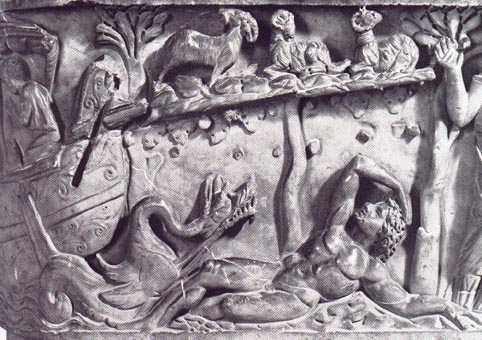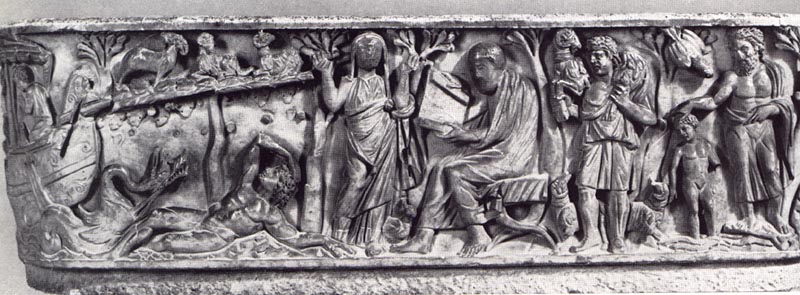
 |
Freethought & Rationalism ArchiveThe archives are read only. |
|
|||||||
|
|
Thread Tools | Search this Thread |
|
|
#31 | ||
|
Contributor
Join Date: Mar 2006
Location: Falls Creek, Oz.
Posts: 11,192
|
Quote:
Quote:
|
||
|
|
|
|
#32 | ||||
|
Contributor
Join Date: Mar 2006
Location: Falls Creek, Oz.
Posts: 11,192
|
Quote:
Quote:
Quote:
"Likely the oldest example of Early Christian plastic art",The problem does not stop there however, because every single citation page after page has the same difficulty. Evidence is being presented and being claimed to be christian. Its a bit like finding a new continent of archaeological relics and sticking a flag into it and claiming it in the name of christianity. The history of this business goes back to the 19th century Papal archaeologist de Rossi. Quote:
Here is a high res pic of the "ketus":  Here is the full [picture again ...  The caption reads .... Plate 13: "The sarcophagus located in Sta. Maria Antiqua, Rome.The evidence presented in "Ante pacem" -- that is "Before the Peace [of Constantine] - is clearly being presented with an extraordinary degree of hegemonic poetic/artistic licence. At the end of the day people may ask you what evidence do you believe in for "christian church life" before the appearance of Constantine, and you will be able to cite "THE Baptism of Jesus" and Graydon Snyder. Good luck!  Do the SBL publish archaeological "evidence" such as this? Have any contributors to the SBL challenged Snyder's "evidence"? People tell me all the time there is plenty of "evidence" before Constantine. |
||||
|
|
|
|
#33 | |
|
Contributor
Join Date: Mar 2006
Location: Falls Creek, Oz.
Posts: 11,192
|
Quote:
What is the logic of your contempt Doug? Is it expressible? |
|
|
|
|
|
#34 |
|
Veteran Member
Join Date: Oct 2007
Location: look behind you...
Posts: 2,107
|
But it is certain a large christian population existed in Rome at the time of Constantine.
Most of them were commoners and slaves and not the citizens of Rome. But Constantine need the backing of the people because he did not have backing in the senate. His move to christianity gave him the support (at least in numbers) to return to Rome as ruler. We would have to think that the upper class (who owned slaves) and interacted with the working class, would have had a pretty good handle on what the religion was all about. Constantines move was well calculated and gave him the appearance of a new christian ruler. Which by most standards would have been forgiving of his enemies. As for art? Probably not much works were done till after the ruling class came on board. |
|
|
|
|
#35 | ||
|
Contributor
Join Date: Mar 2006
Location: Falls Creek, Oz.
Posts: 11,192
|
Quote:
Quote:
We have no christian churches or christian church-houses identified by the archaeologists before Constantine despite the assertions of their existence by Eusebius. We have a third rate monumental church structure, namely the christian "house-church", spotlighted for royal treatment in "Church Life before Constantine". This is of course the Dura-Europos "house church" which has been suspected to be a christian exemplar on the basis of the artworks and murals which purportedly adorned its walls. It was shipped back to Yale Divinity College in the late 1920's for "restoration works". As for other evidence? The coinage of the Roman Emperors sponsors the Graeco-Roman (or "pagan" if you dont mind the anachronism) gods and their families. The papyri fragments themselves do not certainly wave dates before Constantine. None of the "Early Christian papyri" are dated with any certainty, and none have been C14 dated. Their "early dating" is a direct result of a signed attestation by a duly qualified paleographer - there is nothing "certain" in this process. The population of christians in the Roman empire has been conjecturally estimated by a great range of people. Every single one of these estimates has been derived from one of two AUTHORITATIVE sources: 1) The new testament canon, and 2) the literary output of "Eusebius". I can understand if you are willing to place your trust in these authorities. Likewise I hope you can understand that I refuse to accept this authority and therefore I am simply questioning these traditional authorities by searching for any non-tenditious corroborating evidence from the field of ancient history. Do you have any such evidence to bring to this discussion? |
||
|
|
|
|
#36 | |
|
Contributor
Join Date: Jun 2000
Location: Los Angeles area
Posts: 40,549
|
3rd century inscriptions a ring inscribed to Jesus Christ (no nomina sacra)
3rd -4th century symbols has a charm with XREISTOU Quote:
|
|
|
|
|
|
#37 | |||
|
Veteran Member
Join Date: Aug 2004
Location: Orlando
Posts: 2,014
|
Hi Toto,
This is excellent and interesting. I am wondering about this association with fish and shepherds. It does not appear obvious why these things are associated with Jesus. Consider the fish, Jesus and some of his apostles are fishermen and Jesus does say to Peter, "I will make you fisher of men." But shouldn't this mean that Jesus and his followers should be connected with fishermen and not fish? It might imply that I am a fish that Jesus has caught, but that is a strangely derogatory representation. Who wants to be compared to a fish? There is the good shepherd parable in the gospel of John only. That hardly seems to fit with Jesus very well: Quote:
Can we be sure that these symbols of Fish and Shepherds really have anything to do with the Christianity that we know? As far as the inscription, I think that is interesting that as read the words would form a rhyme  I believe the words would be pronounced Yessou Chrestou. This is very much like "hocus pocus" or "abra cadabra" We know that these words were used in exorcisms. It might have been that the charms with these words on them were sold just as exotic magic charms, with people producing and buying them having no relationship to any Christian Church at all. Analogously, Picasso had an interest in African Masks and some of his paintings include African Masks. However it would be a mistake to assume that these paintings came from Africa or were bought by Africans.  I wonder if there is any literature that really ties these symbols to the early Christian Church? Warmly, Philosopher Jay Quote:
|
|||
|
|
|
|
#38 | |||||
|
Contributor
Join Date: Jun 2000
Location: Los Angeles area
Posts: 40,549
|
Quote:
Quote:
Quote:
I'm not claiming that we really know much about these Christians. But I think they are the forerunners of Christians we do know about, and evidence that Eusebius did not invent Christianity out of thin air. Quote:
You might have heard that Hocus Pocus might be a corruption of the Latin Eucharist phrase "Hic est corpus meum." Quote:
And I don't think anyone would confuse Picasso's African-inspired masks with the real thing. |
|||||
|
|
|
|
#39 |
|
Veteran Member
Join Date: Sep 2005
Location: San Bernardino, Calif.
Posts: 5,435
|
|
|
|
|
|
#40 | |||
|
Veteran Member
Join Date: Jul 2008
Location: Location: eastern North America
Posts: 1,468
|
Quote:
I am uncertain about the dates of those rings portrayed in your links, purportedly 2nd-third centuries, not fourth. Here is a little different view of the significance of chi-rho as it first appeared on the helmet in 315CE. Quote:
avi |
|||
|
|
| Thread Tools | Search this Thread |
|